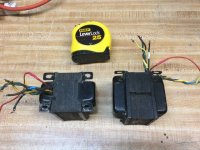How high a B+ you suppose I can get away with using vertical deflection tubes rated at 400? Don’t need too much current - probably keeping g2 around 120. OPTs are 10k. Planning the power trafo wind now. Got some 216 watt cores and finally some 4.5” end bells. I suppose I could use some 7591s (EH) laying around, but they’re capable of more power than these OPTs I want to use are. Rather use some $5 tubes for this project. Looking for about 20W/ch integrated. 400 volts on my impedance will barely get me there if I’m getting 95% regulation which won’t happen so I’m thinking about upping it a bit to get around 390 under load. Just wanted to get an idea of what I can get away with. Got a couple possible choices on hand for tubes - 6LR8’s and 10JA5’s. The former have built in triodes for the driver stage.
No, this ain’t gonna be no Williamson. Tried that with these trafos and it won’t get stable unless i triode strap the finals. That’s a waste of EL34’s - rather put them in something bigger when I find some decent output iron. I’m thinking the same topology as the 26DQ5 bass guitar amp I just finished. Or perhaps an LTP front end, directly coupled to the 2nd LTP.
No, this ain’t gonna be no Williamson. Tried that with these trafos and it won’t get stable unless i triode strap the finals. That’s a waste of EL34’s - rather put them in something bigger when I find some decent output iron. I’m thinking the same topology as the 26DQ5 bass guitar amp I just finished. Or perhaps an LTP front end, directly coupled to the 2nd LTP.
How high a B+ you suppose I can get away with using vertical deflection tubes rated at 400?
It's really hard to say. In case of trouble you'd better stay within the ratings. In real life, though, a frame output tube plate sees pulses in the kV range, every time when they switch off the transformer's primary current.
Best regards!
It's really hard to say. In case of trouble you'd better stay within the ratings. In real life, though, a frame output tube plate sees pulses in the kV range, every time when they switch off the transformer's primary current. Best regards!
^yes to that and in some power tubes it is quoted at 7kv....
The max plate pulse voltage for the 6LR8 / 6LU8 is 2500 volts. I have run them at 450 volts into a 6600 ohm OPT without issue.
The issue with running tubes well beyond their plate voltage ratings is not the voltage, it's usually plate dissipation. You will need a certain idle current to kill all crossover distortion. This varies with different tube types, and the circuit design. At some point idle plate dissipation becomes too high.
In class AB tube amps I try to stay below 75% of max dissipation at idle, preferably lower. This made the limiting point on 6HJ5's around 600 volts since 30 ma was needed to make low THD at 100 mW output. On the other end, I was getting 125 watts at 3% THD from a pair of tubes.
Guess I should run an experiment or two first. See if these are happy at 20 mA of bias. The lasts couple of amps I built were. I was pretty surprised to find that my 6550 monster had good “first watt” performance at as little as 15 mA per tube. I did end up going to 25, but saw no reason to go higher. The 26DQ5 bass amp ended up at 20 mA per tube, with the waveform looking pretty good at half a watt open loop so I didn’t even bother to experiment further.
The max plate pulse voltage for the 6LR8 / 6LU8 is 2500 volts. I have run them at 450 volts into a 6600 ohm OPT without issue.
The issue with running tubes well beyond their plate voltage ratings is not the voltage, it's usually plate dissipation. You will need a certain idle current to kill all crossover distortion. This varies with different tube types, and the circuit design. At some point idle plate dissipation becomes too high.
In class AB tube amps I try to stay below 75% of max dissipation at idle, preferably lower. This made the limiting point on 6HJ5's around 600 volts since 30 ma was needed to make low THD at 100 mW output. On the other end, I was getting 125 watts at 3% THD from a pair of tubes.
Correct, the issue with voltage is what we would call these days something like clearance or creepage distance.
After a while you just run the risk of sparking, simply said.
The dissipation is rather an issue with current vs power vs longevity.
Exactly like your (old) light bulb. You can run them more hot, but they won't last as long.
Class-A (SE) amps usually run around 85% to sometimes even 95%.
But there's loads here!!!!
https://www.diyaudio.com/forums/search.php?searchid=24504148
https://www.diyaudio.com/forums/search.php?searchid=24504148
- Home
- Amplifiers
- Tubes / Valves
- Those Magnificent Television Tubes
